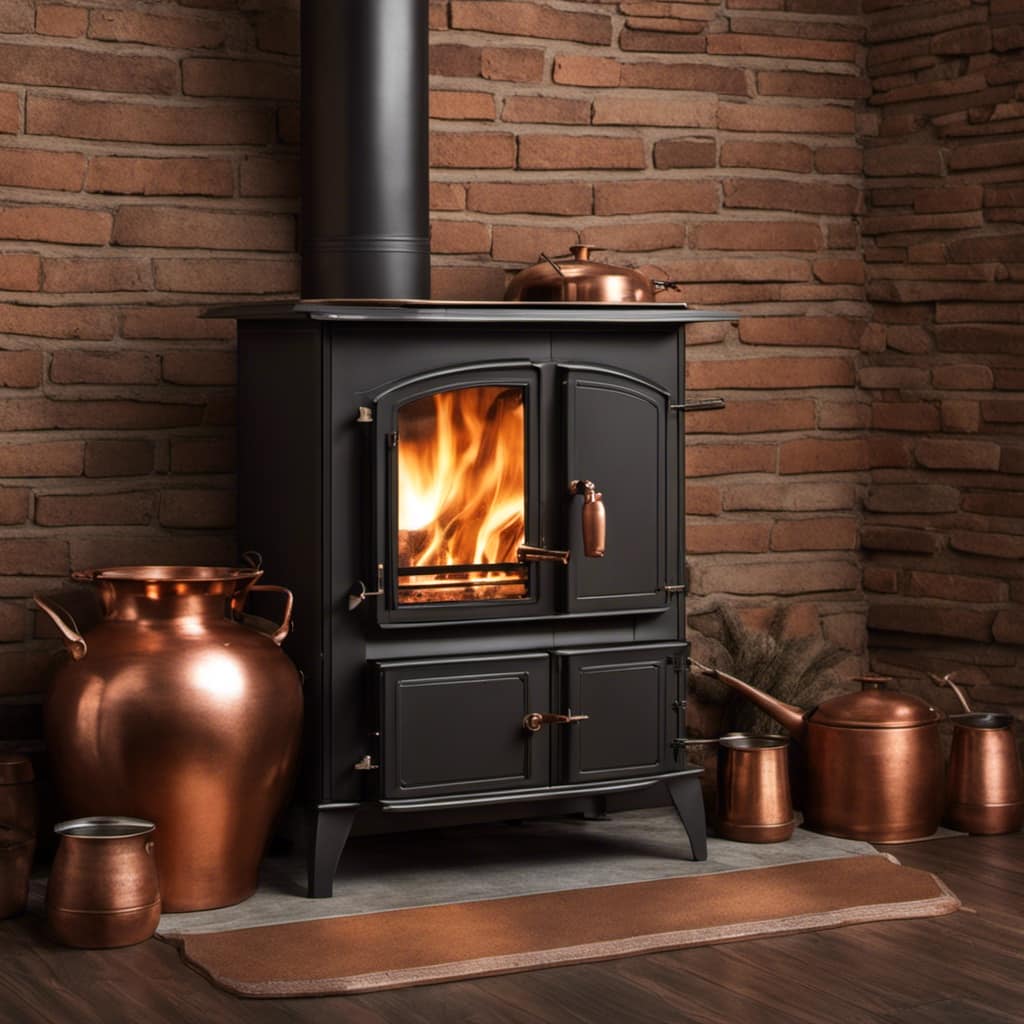Sitting by my wood stove, I observed the subtle drift of smoke coming through tiny openings. It was evident that a replacement gasket was necessary.
In this guide, I’ll show you step-by-step how to replace the worn-out gasket with precision and ease. With just a few tools and materials, you’ll have your wood stove sealed tightly, ensuring maximum efficiency and minimizing smoke leakage.
Let’s get started on this essential maintenance task.
Key Takeaways
- Wear gloves and protective eyewear when removing the old gasket to ensure safety.
- Clean the surface thoroughly and ensure it is dry before applying adhesive for the gasket replacement.
- Properly align and secure the new gasket using the appropriate adhesive.
- Test the gasket for proper alignment, perform smoke and temperature tests, and troubleshoot any issues that arise during testing.
Tools and Materials Needed
I need a screwdriver and some adhesive for the wood stove gasket replacement.

When it comes to changing the gasket on a wood stove, having the right tools and techniques is crucial for a successful installation.
First and foremost, a screwdriver is essential for removing the old gasket and securing the new one in place. It’s important to choose a screwdriver that fits the screws on your particular stove model to avoid any damage.
Additionally, having some adhesive is necessary to ensure a tight seal between the gasket and the stove door. There are various types of adhesive available, but it’s recommended to use high-temperature adhesive specifically designed for wood stoves.
Removing the Old Gasket
Before securing the new gasket, it’s important to remove the old gasket using a screwdriver.

The cleaning process for removing the old gasket from a wood stove is essential to ensure proper installation of the new gasket. First, I recommend wearing gloves and protective eyewear to prevent any injuries.
Start by locating the gasket around the door or glass of the wood stove. Carefully insert the screwdriver between the gasket and the stove, gently prying it away. Be cautious not to damage the stove’s surface.
Once the gasket is loosened, continue to remove it by pulling it away from the stove. Clean any remaining adhesive residue with a scraper or sandpaper.
Troubleshooting tip: If the gasket is stubborn, applying heat from a hairdryer can help soften the adhesive, making it easier to remove.

Preparing the Surface
After removing the old gasket, I carefully clean the surface of the wood stove with a damp cloth and then wipe it down with a dry cloth before applying the new gasket. Cleaning the surface is crucial to ensure proper adhesion of the new gasket.
Here are three important steps to prepare the surface:
Remove any debris or loose particles from the surface using a brush or vacuum cleaner. This will create a clean and smooth surface for the adhesive to bond with.
Use a mild detergent or stove cleaner to remove any stubborn stains or grease. Be sure to follow the instructions on the cleaner and rinse thoroughly to avoid any residue that may affect the gasket’s performance.

Allow the surface to dry completely before applying the adhesive. Moisture can interfere with the adhesive’s effectiveness, so it’s important to ensure the surface is completely dry.
Installing the New Gasket
Now that the surface is prepared, it’s important to carefully align the new gasket before securing it in place with adhesive. This step is crucial to ensure a proper and effective seal for your wood stove.
When installing a new gasket, it’s important to troubleshoot common installation issues that may arise. One common problem is the gasket not adhering properly to the stove due to uneven surfaces or improper alignment. To address this, make sure to thoroughly clean the surface and remove any debris before applying adhesive.
Additionally, choosing the right gasket material for your wood stove is essential. Different materials, such as fiberglass, rope, or tape, have different heat resistance and durability levels. Consider factors such as temperature, frequency of use, and stove type when selecting the appropriate gasket material.

Testing and Final Steps
I need to perform a series of tests to ensure the new gasket is properly sealed and ready for use. Here are some testing techniques and troubleshooting tips to ensure a successful installation:
Visual Inspection: Start by visually inspecting the gasket to ensure it’s properly aligned and secured. Look for any gaps, tears, or loose ends that may compromise the seal.
Smoke Test: Light a small piece of paper and hold it near the gasket. If you notice any smoke escaping, it indicates a leak that needs to be addressed.
Temperature Test: Once the stove is fully heated, carefully feel around the gasket area for any hot spots or heat escaping. This can help identify any areas that need further sealing.

Are the Steps to Change a Wood Stove Gasket Different for a Glass Door?
Yes, the steps for putting gasket on a glass door of a wood stove are slightly different compared to a regular door. When changing the gasket on a glass door, ensure that the gasket is properly sized and the door is clean before installation.
Frequently Asked Questions
How Often Do Wood Stove Gaskets Need to Be Replaced?
Wood stove gaskets typically need to be replaced every 1-3 years, depending on usage. Signs of a worn gasket include smoke leakage, difficulty in maintaining a fire, and visible wear or damage. Regular cleaning and inspection can help prolong the lifespan.
Can I Use Any Type of Adhesive to Install the New Gasket?
I wouldn’t recommend using just any adhesive to install a new wood stove gasket. It’s important to choose the right type of adhesive that is specifically designed for wood stove gaskets. Proper installation techniques are also crucial for a successful replacement.
Is It Necessary to Completely Remove the Old Gasket Before Installing the New One?
It is not necessary to completely remove the old gasket before installing the new one. However, it is not possible to reuse the old gasket. Common problems with wood stove gaskets include wear, tear, and degradation over time.
Can I Use a Different Type of Material for the New Gasket?
I recently changed the gasket on my wood stove and found that using a different type of material for the new gasket worked well. There are alternative gasket options available that can provide a better seal and improved heat resistance.

How Long Does It Take for the Adhesive to Fully Cure Before I Can Use My Wood Stove Again?
The adhesive curing time for the wood stove gasket depends on the specific product used. It is crucial to follow the manufacturer’s instructions to ensure a proper cure. Alternative gasket materials may have different curing times.
Conclusion
After following these steps to change the wood stove gasket, you’ll be able to enjoy a more efficient and reliable wood stove. Remember, a well-maintained gasket ensures proper sealing, preventing air leakage and maximizing heat output. So don’t hesitate to take the time to replace the gasket when needed.
With just a few tools and some patience, you’ll have your wood stove up and running smoothly in no time. Keep your home warm and cozy with a properly sealed wood stove!
Growing up surrounded by the vast beauty of nature, Sierra was always drawn to the call of the wild. While others sought the comfort of the familiar, she ventured out, embracing the unpredictable and finding stories in the heartbeat of nature.
At the epicenter of every remarkable venture lies a dynamic team—a fusion of diverse talents, visions, and passions. The essence of Best Small Wood Stoves is crafted and refined by such a trio: Sierra, Logan, and Terra. Their collective expertise has transformed the platform into a leading authority on small wood stoves, radiating warmth and knowledge in equal measure.











